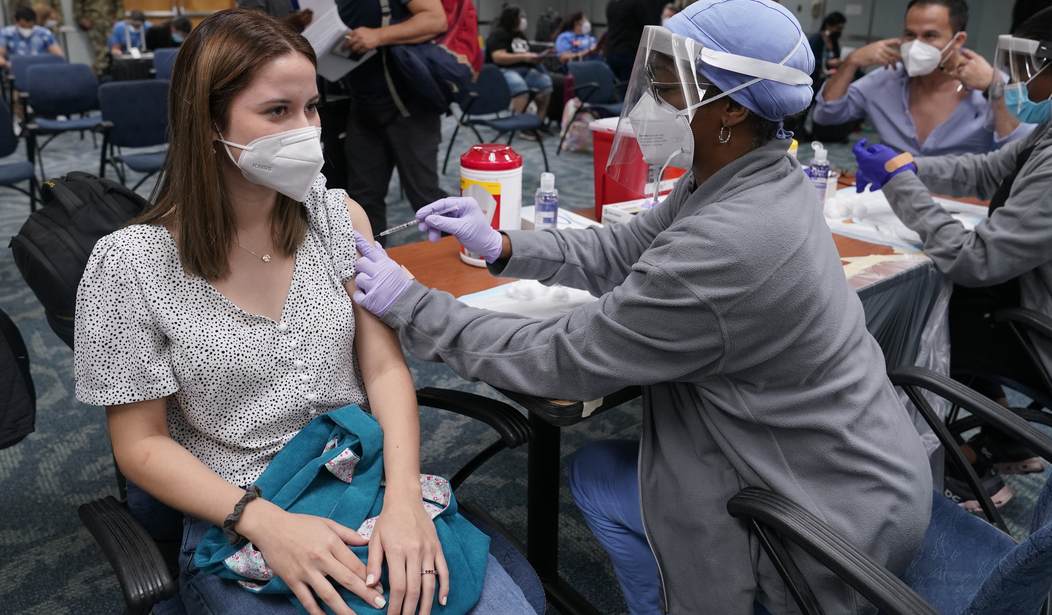Has the world overreacted to the latest COVID variant? The latest New York Times report doesn’t explicitly say so, but the news out of South Africa certainly hints at it. Omicron does cause off-the-charts transmission and confirmed cases have soared, but few if any hospitalizations have been triggered by the variant:
The Covid-19 virus is spreading faster than ever in South Africa, the country’s president said Monday, an indication of how the new Omicron variant is driving the pandemic, but there are early indications that Omicron may cause less serious illness than other forms of the virus.
Researchers at a major hospital complex in Pretoria reported that their patients with the coronavirus are much less sick than those they have treated before, and that other hospitals are seeing the same trends. In fact, they said, most of their infected patients were admitted for other reasons and have no Covid symptoms.
But scientists cautioned against placing too much stock in either the potential good news of less severity, or bad news like early evidence that prior coronavirus infection offers little immunity to Omicron. The variant was discovered just last month, and more study is needed before experts can say much about it with confidence. Beyond that, the true impact of the coronavirus is not always felt immediately, with hospitalizations and deaths often lagging considerably behind initial outbreaks.
This gets to a point that sometimes gets lost in the debate over the public response to variants. There isn’t a binary choice between panic and doing nothing; there is a long spectrum of choices between “lock everything down now!” and “let ‘er rip!” A temporary suspension of travel between a new hotspot for transmission and countries believed to be free of a variant is a step that makes some sense while epidemiologists try to make sense of the risk. Forcing everyone to get vaccinated at the risk of losing their jobs in response to a new variant is nutty, especially when no one’s quite sure whether and which vaccines work against it.
This NYT story is playing catch-up to other reports on Omicron, too. Allahpundit covered most of these developments from other sources over the weekend in two posts, one of which noted that Omicron seems to outcompete Delta in places where both strains are transmitting. That could be a big problem if Omicron results in serious consequences — and right now, we don’t know the answer to that. Its genetic makeup makes it more likely to keep evolving, which creates problems for vaccine development and might require a new Operation Warp Speed if Omicron spins off its own variants. All of those concerns are separate from the acute-hospitalization and severe-COVID-pneumonia issues we have from other variants — perhaps much less serious too, but still a public-health concern.
What we are beginning to discover about Omicron, however, is that those latter concerns about acute and severe disease so far are not manifesting in South Africa, or anywhere else. Deaths tend to lag a couple of weeks behind big spikes in case transmissions, but South Africa is a month into its fourth Omicron-driven wave of COVID cases. And thus far, deaths have declined:

Even the low number of hospitalizations tagged with Omicron turn out to overstate the impact:
A report released this weekend from doctors at the Steve Biko Academic and Tshwane District Hospital Complex in Pretoria, South Africa’s administrative capital, offers the strongest support yet for a more hopeful take on Omicron, though its author, Dr. Fareed Abdullah, gave reasons to be wary of drawing conclusions. …
Most of the patients were admitted “for diagnoses unrelated to Covid-19,” the report said, and their infection “is an incidental finding in these patients and is largely driven by hospital policy requiring testing of all patients.” It said that two other large hospitals in Gauteng Province, which includes Pretoria and Johannesburg, had even lower percentages of infected patients needing oxygen.
It’s possible that Omicron is a bridge to human tolerance of COVID. It may be wildly transmissible, but if it remains largely benign, it means that it may more like a mild flu strain. However, like even a mild flu, a variant of Omicron could turn out to be much less benign down the road, which is why epidemiologists are right to worry about its spread and dominance against variants for which we already have significant vaccine protection.
The NYT’s David Leonhardt, who has done excellent reporting on the pandemic from the beginning, covers four big questions about Omicron this morning, and concludes that it’s not an occasion for massive public-policy swings:
“What is hard to assess right now,” Jennifer Nuzzo of Johns Hopkins University said, “is how this will play out if or when older and more vulnerable people become infected.”
But other scientists believe that the early signs are clearer and more positive. If anything, they say, Omicron may be milder than previous variants. Hospitalization and death rates in South Africa have not soared even as cases have. Intriguingly, patients are reporting less loss of taste and smell.
Dr. David Dowdy, another Johns Hopkins epidemiologist, told me that he happened to have a close research collaboration with scientists in Tshwane, a South African city at the epicenter of the outbreak. His colleagues there have told him that hospitalizations and oxygen demand are lower than during previous waves. “I think the signs are actually extremely optimistic,” he said. …
For now, vaccinated people can reasonably continue to behave as they were — but many should feel urgency about getting booster shots. Older people and others who are vulnerable, like people receiving cancer treatment, should continue to be careful and ask people around them to test frequently.
At some point, we will all have to understand that COVID and variants will be part of human life from this point forward. There is no “stamping it out”; there will only be “learning to live with it.” That means proper caution rather than panic or foolhardiness, and policies oriented to integrating mitigation into normal life rather than canceling normal life as our form of mitigation.
Addendum: Does Bill de Blasio read the NYT?








Join the conversation as a VIP Member